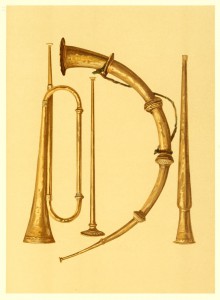TUTURI. NAFARI. S’RINGA. KURNA
THE curved brass horn in this plate is the S’ringa or S’ing, called
in Southern India Kahalay or Kombu. It is frequently found with
a metal rod connecting both ends. This horn is used universally
through India for signals, watch setting processions, and the like, both
by Mahomedans and Hindus, though the performers for the most part are
Hindus of low caste.
The large trumpet with one turn is called the Tuturi. This name is usually
applied to what might be called the tenor trumpet, as distinguished from the
Kurna, the large straight trumpet drawn at the bottom of the plate. The tuturi —
or turi — is made in various sizes and is used principally in religious ceremonies.
The small straight trumpet is the Nafari.
The Kurna — called in Southern India Buruga or Banku — is used onlv on
solemn occasions, and possesses but a few hoarse sounds. In fact, no Indian
trumpets are capable of producing many notes, they are invariably of the most
primitive description, and no attempt is made to play them scientifically : indeed,
their proper compass is not even understood.

